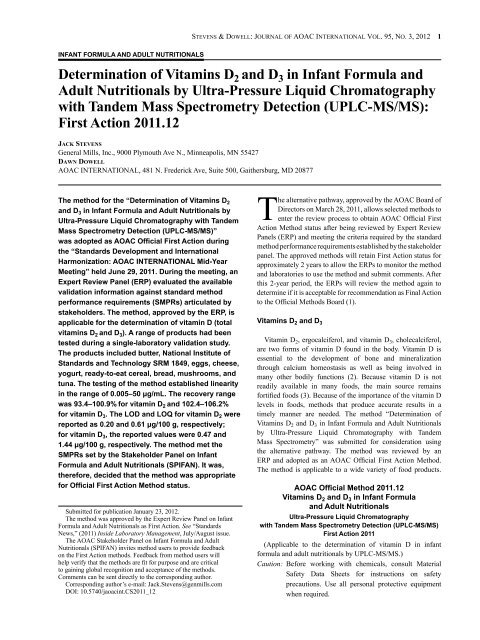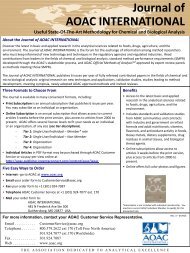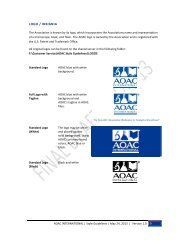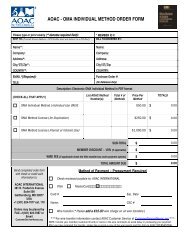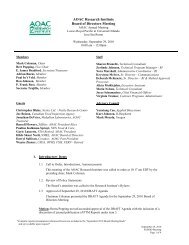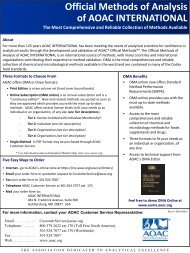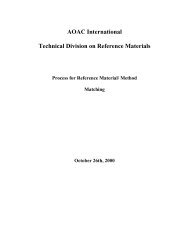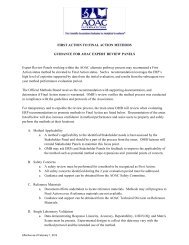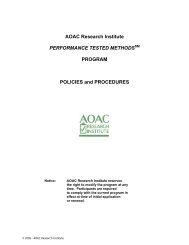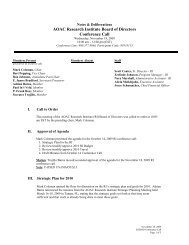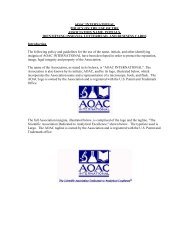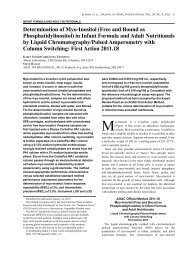Determination of Vitamins D2 and D3 in Infant - AOAC International
Determination of Vitamins D2 and D3 in Infant - AOAC International
Determination of Vitamins D2 and D3 in Infant - AOAC International
You also want an ePaper? Increase the reach of your titles
YUMPU automatically turns print PDFs into web optimized ePapers that Google loves.
INFANT FORMULA AND ADULT NUTRITIONALS<br />
StevenS & Dowell: Journal <strong>of</strong> aoaC InternatIonal vol. 95, no. 3, 2012 1<br />
<strong>Determ<strong>in</strong>ation</strong> <strong>of</strong> <strong>Vitam<strong>in</strong>s</strong> D 2 <strong>and</strong> D 3 <strong>in</strong> <strong>Infant</strong> Formula <strong>and</strong><br />
Adult Nutritionals by Ultra-Pressure Liquid Chromatography<br />
with T<strong>and</strong>em Mass Spectrometry Detection (UPLC-MS/MS):<br />
First Action 2011.12<br />
Jack StevenS<br />
General Mills, Inc., 9000 Plymouth Ave N., M<strong>in</strong>neapolis, MN 55427<br />
Dawn Dowell<br />
<strong>AOAC</strong> INTERNATIONAL, 481 N. Frederick Ave, Suite 500, Gaithersburg, MD 20877<br />
The method for the “<strong>Determ<strong>in</strong>ation</strong> <strong>of</strong> <strong>Vitam<strong>in</strong>s</strong> D 2<br />
<strong>and</strong> D 3 <strong>in</strong> <strong>Infant</strong> Formula <strong>and</strong> Adult Nutritionals by<br />
Ultra-Pressure Liquid Chromatography with T<strong>and</strong>em<br />
Mass Spectrometry Detection (UPLC-MS/MS)”<br />
was adopted as <strong>AOAC</strong> Official First Action dur<strong>in</strong>g<br />
the “St<strong>and</strong>ards Development <strong>and</strong> <strong>International</strong><br />
Harmonization: <strong>AOAC</strong> INTERNATIONAL Mid-Year<br />
Meet<strong>in</strong>g” held June 29, 2011. Dur<strong>in</strong>g the meet<strong>in</strong>g, an<br />
Expert Review Panel (ERP) evaluated the available<br />
validation <strong>in</strong>formation aga<strong>in</strong>st st<strong>and</strong>ard method<br />
performance requirements (SMPRs) articulated by<br />
stakeholders. The method, approved by the ERP, is<br />
applicable for the determ<strong>in</strong>ation <strong>of</strong> vitam<strong>in</strong> D (total<br />
vitam<strong>in</strong>s D 2 <strong>and</strong> D 3). A range <strong>of</strong> products had been<br />
tested dur<strong>in</strong>g a s<strong>in</strong>gle-laboratory validation study.<br />
The products <strong>in</strong>cluded butter, National Institute <strong>of</strong><br />
St<strong>and</strong>ards <strong>and</strong> Technology SRM 1849, eggs, cheese,<br />
yogurt, ready-to-eat cereal, bread, mushrooms, <strong>and</strong><br />
tuna. The test<strong>in</strong>g <strong>of</strong> the method established l<strong>in</strong>earity<br />
<strong>in</strong> the range <strong>of</strong> 0.005–50 μg/mL. The recovery range<br />
was 93.4–100.9% for vitam<strong>in</strong> D 2 <strong>and</strong> 102.4–106.2%<br />
for vitam<strong>in</strong> D 3. The LOD <strong>and</strong> LOQ for vitam<strong>in</strong> D 2 were<br />
reported as 0.20 <strong>and</strong> 0.61 μg/100 g, respectively;<br />
for vitam<strong>in</strong> D 3, the reported values were 0.47 <strong>and</strong><br />
1.44 μg/100 g, respectively. The method met the<br />
SMPRs set by the Stakeholder Panel on <strong>Infant</strong><br />
Formula <strong>and</strong> Adult Nutritionals (SPIFAN). It was,<br />
therefore, decided that the method was appropriate<br />
for Official First Action Method status.<br />
Submitted for publication January 23, 2012.<br />
The method was approved by the Expert Review Panel on <strong>Infant</strong><br />
Formula <strong>and</strong> Adult Nutritionals as First Action. See “St<strong>and</strong>ards<br />
News,” (2011) Inside Laboratory Management, July/August issue.<br />
The <strong>AOAC</strong> Stakeholder Panel on <strong>Infant</strong> Formula <strong>and</strong> Adult<br />
Nutritionals (SPIFAN) <strong>in</strong>vites method users to provide feedback<br />
on the First Action methods. Feedback from method users will<br />
help verify that the methods are fit for purpose <strong>and</strong> are critical<br />
to ga<strong>in</strong><strong>in</strong>g global recognition <strong>and</strong> acceptance <strong>of</strong> the methods.<br />
Comments can be sent directly to the correspond<strong>in</strong>g author.<br />
Correspond<strong>in</strong>g author’s e-mail: Jack.Stevens@genmills.com<br />
DOI: 10.5740/jaoac<strong>in</strong>t.CS2011_12<br />
The alternative pathway, approved by the <strong>AOAC</strong> Board <strong>of</strong><br />
Directors on March 28, 2011, allows selected methods to<br />
enter the review process to obta<strong>in</strong> <strong>AOAC</strong> Official First<br />
Action Method status after be<strong>in</strong>g reviewed by Expert Review<br />
Panels (ERP) <strong>and</strong> meet<strong>in</strong>g the criteria required by the st<strong>and</strong>ard<br />
method performance requirements established by the stakeholder<br />
panel. The approved methods will reta<strong>in</strong> First Action status for<br />
approximately 2 years to allow the ERPs to monitor the method<br />
<strong>and</strong> laboratories to use the method <strong>and</strong> submit comments. After<br />
this 2-year period, the ERPs will review the method aga<strong>in</strong> to<br />
determ<strong>in</strong>e if it is acceptable for recommendation as F<strong>in</strong>al Action<br />
to the Official Methods Board (1).<br />
<strong>Vitam<strong>in</strong>s</strong> D 2 <strong>and</strong> D 3<br />
Vitam<strong>in</strong> D 2, ergocalciferol, <strong>and</strong> vitam<strong>in</strong> D 3, cholecalciferol,<br />
are two forms <strong>of</strong> vitam<strong>in</strong> D found <strong>in</strong> the body. Vitam<strong>in</strong> D is<br />
essential to the development <strong>of</strong> bone <strong>and</strong> m<strong>in</strong>eralization<br />
through calcium homeostasis as well as be<strong>in</strong>g <strong>in</strong>volved <strong>in</strong><br />
many other bodily functions (2). Because vitam<strong>in</strong> D is not<br />
readily available <strong>in</strong> many foods, the ma<strong>in</strong> source rema<strong>in</strong>s<br />
fortified foods (3). Because <strong>of</strong> the importance <strong>of</strong> the vitam<strong>in</strong> D<br />
levels <strong>in</strong> foods, methods that produce accurate results <strong>in</strong> a<br />
timely manner are needed. The method “<strong>Determ<strong>in</strong>ation</strong> <strong>of</strong><br />
<strong>Vitam<strong>in</strong>s</strong> D 2 <strong>and</strong> D 3 <strong>in</strong> <strong>Infant</strong> Formula <strong>and</strong> Adult Nutritionals<br />
by Ultra-Pressure Liquid Chromatography with T<strong>and</strong>em<br />
Mass Spectrometry” was submitted for consideration us<strong>in</strong>g<br />
the alternative pathway. The method was reviewed by an<br />
ERP <strong>and</strong> adopted as an <strong>AOAC</strong> Official First Action Method.<br />
The method is applicable to a wide variety <strong>of</strong> food products.<br />
<strong>AOAC</strong> Official Method 2011.12<br />
<strong>Vitam<strong>in</strong>s</strong> <strong>D2</strong> <strong>and</strong> <strong>D3</strong> <strong>in</strong> <strong>Infant</strong> Formula<br />
<strong>and</strong> Adult Nutritionals<br />
Ultra-Pressure Liquid Chromatography<br />
with T<strong>and</strong>em Mass Spectrometry Detection (UPLC-MS/MS)<br />
First Action 2011<br />
(Applicable to the determ<strong>in</strong>ation <strong>of</strong> vitam<strong>in</strong> D <strong>in</strong> <strong>in</strong>fant<br />
formula <strong>and</strong> adult nutritionals by UPLC-MS/MS.)<br />
Caution: Before work<strong>in</strong>g with chemicals, consult Material<br />
Safety Data Sheets for <strong>in</strong>structions on safety<br />
precautions. Use all personal protective equipment<br />
when required.
2 StevenS & Dowell: Journal <strong>of</strong> aoaC InternatIonal vol. 95, no. 3, 2012<br />
Table 2011.12A. Sample dispensation guidel<strong>in</strong>es<br />
for vitam<strong>in</strong> D analysis<br />
Vitam<strong>in</strong> D samples Quantity, g<br />
Ready-to-eat cereal >5<br />
NIST 1849 <strong>Infant</strong>/Adult Nutritional Formula 1<br />
Bread >5<br />
Mushrooms >10<br />
Eggs 2–3<br />
Yogurt 20–25<br />
Cheese 2–3<br />
Fish 2–3<br />
Butter 3–5<br />
Milk, RTF <strong>in</strong>fant formula 20–25<br />
Premix
Table 2011.12D. MS method: Vitam<strong>in</strong> D a<br />
Analyte<br />
Parent,<br />
m/z<br />
Daughter,<br />
m/z<br />
Phillipsburg, NJ).<br />
(b) Ethanol.—200 pro<strong>of</strong>, HPLC grade; No. 459828 (Sigma-<br />
Aldrich).<br />
(c) Ammonium formate Fluka.—No. 70221-25g-f (Sigma-<br />
Aldrich).<br />
(d) Pyrogallic acid.—No. JT0288-01 (J.T. Baker).<br />
(e) Ascorbic acid.—U.S. Pharmacopeia (USP) grade;<br />
Mall<strong>in</strong>ckrodt No. MK882903 (Phillipsburg, NJ).<br />
(f) Methylene chloride.—HPLC grade; EMD Omnisolv No.<br />
PX1834-6 (Gibbstown, NJ).<br />
(g) Isopropanol.—HPLC grade; EMD Omnisolv No.<br />
PX1834-6.<br />
(h) 2,6-Di-tert-butyl-4-methylphenol (BHT).—Sigma-<br />
Aldrich No. B1378.<br />
(i) Methanol.—Chromasolv LC/MS grade; Sigma-Aldrich<br />
No. 34966.<br />
(j) Potassium hydroxide.—50% (w/v); No. BDH3622-1<br />
(BDH, VWR <strong>International</strong> LLC).<br />
(k) Sodium sulfate anhydrous.—Granular 12-60 mesh; J.T.<br />
Baker No. JT3375-5.<br />
(l) Purified water.—(>18 MΩ) Nanopure.<br />
(m) Vitam<strong>in</strong> <strong>D3</strong> (cholecalciferol).—Cat. No. 1131009, purity<br />
≥98% (USP, Rockville, MD).<br />
(n) Vitam<strong>in</strong> <strong>D2</strong> (ergocalciferol).—Cat. No. 1239005, purity<br />
≥98% (USP).<br />
(o) Vitam<strong>in</strong> <strong>D3</strong> [ 2 H3] (isotopically labeled).—Cat. No.<br />
S3077-1.0 (1 mg/mL <strong>in</strong> ethanol), purity ≥97% (Isosciences,<br />
K<strong>in</strong>g <strong>of</strong> Prussia, PA).<br />
(p) Vitam<strong>in</strong> <strong>D2</strong> [ 2 H3] (isotopically labeled).—Cat. No.<br />
S5014-0.1 (1 mg/mL <strong>in</strong> ethanol), purity ≥98% (Isosciences).<br />
D. Reagent Preparation<br />
(a) Ethanol (40%, v/v).—Dilute 800 mL 200-pro<strong>of</strong> ethanol<br />
to 1 L.<br />
(b) KOH (50%, w/v).—(1) Dissolve 500 g KOH pellets <strong>in</strong><br />
500 mL water·KOH (1 M).<br />
(2) Dissolve 56 g KOH pellets <strong>in</strong> water <strong>and</strong> dilute to 1 L.<br />
(c) Mobile phase A1: 2 mM NH 4COOH.—Dissolve 0.126 g<br />
ammonium formate <strong>in</strong> water <strong>and</strong> dilute to 1 L.<br />
StevenS & Dowell: Journal <strong>of</strong> aoaC InternatIonal vol. 95, no. 3, 2012 3<br />
Cone<br />
voltage<br />
Collision<br />
voltage<br />
Vitam<strong>in</strong> <strong>D2</strong> [ 2 H3] (<strong>in</strong>ternal<br />
st<strong>and</strong>ard)<br />
399.89 69.10 20 30<br />
399.89 109.31 20 30<br />
Vitam<strong>in</strong> <strong>D2</strong> 397.6 69.10 20 30<br />
397.6 106.98 20 30<br />
397.6 271.30 20 30<br />
Vitam<strong>in</strong> <strong>D3</strong> [ 2 H3] (<strong>in</strong>ternal<br />
st<strong>and</strong>ard)<br />
388.7 370.6 20 20<br />
388.7 259.6 20 20<br />
Vitam<strong>in</strong> <strong>D3</strong> 385.5 107.15 20 20<br />
385.5 259.10 20 20<br />
a Ionization mode: APCI+, span 0, <strong>in</strong>terchannel delay 0.005,<br />
<strong>in</strong>terscan time 0.005 s, dwell 0.1 s, APCI Probe 550°C.<br />
Table 2011.12E. UPLC-MS/MS operat<strong>in</strong>g parameters<br />
Source parameter Value Analyzer parameter Value<br />
Corona 5 LM resolution 1 <strong>and</strong> 2 5<br />
Cone, V 20 HM resolution 1 <strong>and</strong> 2 5<br />
Extractor, V 10 Ion energy 1 0.1<br />
RF lens, V 0 Ion energy 2 10<br />
Desolvation temp., ±°C 350 Entrance, V 0<br />
Source temp., °C 150 Collision, V 30<br />
Desolvation gas, L/h 350 Exit, V 0<br />
Cone gas flow, L/h 50 Multiplier 850<br />
Probe temp., °C 550 Collision gas flow 0.5<br />
(d) Mobile phase B1: 2 mM NH4COOH–MeOH.—Dissolve 0.126 g ammonium formate <strong>in</strong> methanol <strong>and</strong> dilute to 1 L.<br />
(e) Strong wash solution: 80% MeOH:20% purified H2O.— Dilute 800 mL methanol to 1 L with water.<br />
(f) Weak wash solution: 90% purified H2O:10% MeOH.—<br />
Dilute 100 mL methanol to 1 L with water.<br />
(g) Internal st<strong>and</strong>ard stock solution vitam<strong>in</strong> <strong>D2</strong> [ 2 H3] (0.1 mg/mL).—Dissolve 1 mg/mL vitam<strong>in</strong> <strong>D2</strong> [ 2 H3] <strong>in</strong> 200-pro<strong>of</strong><br />
ethanol <strong>and</strong> dilute to 10 mL.<br />
(h) Internal st<strong>and</strong>ard stock solution vitam<strong>in</strong> <strong>D3</strong> [ 2 H3] (0.1 mg/mL).—Dissolve 1 mg/mL vitam<strong>in</strong> <strong>D3</strong> [ 2 H3] <strong>in</strong> 200-pro<strong>of</strong><br />
ethanol <strong>and</strong> dilute to 10 mL.<br />
(1) 80:20 Methylene chloride:isopropanol solution.—Dilute<br />
800 mL methylene chloride to 1 L with isopropanol.<br />
(2) 99.8:0.2 Methylene chloride:isopropanol solution.—<br />
Dilute 2 mL isopropanol to 1 L with methylene chloride.<br />
(3) Vitam<strong>in</strong> <strong>D2</strong> [ 2 H3]/vitam<strong>in</strong> <strong>D3</strong> [ 2 H3] <strong>in</strong>ternal st<strong>and</strong>ard<br />
work<strong>in</strong>g stock solution (1000 ng/mL).—Dilute 250 µL <strong>in</strong>ternal<br />
st<strong>and</strong>ard stock solution vitam<strong>in</strong> <strong>D2</strong> [ 2 H3] (0.1 mg/mL) <strong>and</strong><br />
250 µL <strong>in</strong>ternal st<strong>and</strong>ard stock solution vitam<strong>in</strong> <strong>D3</strong> [ 2 H3] (0.1 mg/mL) to 25 mL with 200-pro<strong>of</strong> ethanol.<br />
(4) Vitam<strong>in</strong> <strong>D2</strong> stock solution (0.1 mg/mL).—Dissolve 10 mg<br />
vitam<strong>in</strong> <strong>D2</strong> <strong>in</strong> 200-pro<strong>of</strong> ethanol to 100 mL.<br />
(5) Vitam<strong>in</strong> <strong>D3</strong> stock solution (0.1 mg/mL).—Dissolve 10 mg<br />
vitam<strong>in</strong> <strong>D3</strong> <strong>in</strong> 200-pro<strong>of</strong> ethanol to 100 mL.<br />
(6) Vitam<strong>in</strong> <strong>D2</strong>/vitam<strong>in</strong> <strong>D3</strong> st<strong>and</strong>ard work<strong>in</strong>g stock solution<br />
(1000 ng/mL).—Dilute 250 µL vitam<strong>in</strong> <strong>D2</strong> stock solution<br />
(0.1 mg/mL) <strong>and</strong> 250 µL vitam<strong>in</strong> <strong>D3</strong> stock solution (0.1 mg/mL)<br />
<strong>in</strong> 200-pro<strong>of</strong> ethanol to 25 mL.<br />
(7) Vitam<strong>in</strong> D mixed reference st<strong>and</strong>ard (200 ng/mL).—<br />
Dilute 1 mL vitam<strong>in</strong> <strong>D2</strong> [ 2 H3]/vitam<strong>in</strong> <strong>D3</strong> [ 2 H3] <strong>in</strong>ternal st<strong>and</strong>ard<br />
work<strong>in</strong>g stock solution (1000 ng/mL) <strong>and</strong> 1 mL vitam<strong>in</strong> <strong>D2</strong>/ vitam<strong>in</strong> <strong>D3</strong> st<strong>and</strong>ard work<strong>in</strong>g stock solution (1000 ng/mL) to<br />
5 mL.<br />
Note: Stock <strong>and</strong> work<strong>in</strong>g stock solutions are stable <strong>in</strong> the dark<br />
at –20°C for 1 year. Stock solutions should be brought to room<br />
temperature before use. Prepare the vitam<strong>in</strong> D mixed reference<br />
st<strong>and</strong>ard daily.<br />
E. Preparation <strong>of</strong> Test Samples<br />
(a) General preparations <strong>and</strong> <strong>in</strong>structions.—<br />
(1) Homogenize samples <strong>in</strong> air-tight, dark conta<strong>in</strong>ers stored at<br />
or below 8°C.<br />
(2) H<strong>and</strong>l<strong>in</strong>g <strong>and</strong> storage <strong>of</strong> samples should be <strong>in</strong> accordance<br />
with good laboratory practices. Allow refrigerated or frozen
4 StevenS & Dowell: Journal <strong>of</strong> aoaC InternatIonal vol. 95, no. 3, 2012<br />
samples to come to room temperature before weigh<strong>in</strong>g.<br />
(3) Perform all laboratory work under yellow or golden<br />
fluorescent light<strong>in</strong>g conditions for vitam<strong>in</strong> analysis us<strong>in</strong>g either<br />
low act<strong>in</strong>ic or covered clear glassware.<br />
(4) Perform all laboratory work <strong>in</strong> a hood with the exception <strong>of</strong><br />
the Genevac Rocket evaporation systems, sample reconstitution<br />
with methanol, <strong>and</strong> sample analysis on the LC-MS/MS.<br />
(5) Consult the laboratory equipment or analytical <strong>in</strong>strument<br />
operat<strong>in</strong>g manual for preventative <strong>and</strong> rout<strong>in</strong>e ma<strong>in</strong>tenance <strong>of</strong><br />
the equipment utilized <strong>in</strong> this method.<br />
(b) Sample preparation.—(1) Turn on the 6 × 500 mL<br />
heat<strong>in</strong>g mantle 10 m<strong>in</strong> prior to <strong>in</strong>tended use to reach temperature<br />
equilibrium.<br />
(2) Dispense an appropriate quantity <strong>of</strong> sample <strong>in</strong>to a 500 mL<br />
round-bottom flask based on Table 2011.12A as a guide. Record<br />
the weight to 0.001 g for food <strong>and</strong> 0.0001 g for vitam<strong>in</strong> D<br />
premix samples.<br />
(3) Add a stir bar <strong>and</strong> a few boil<strong>in</strong>g chips to each flask, <strong>and</strong><br />
add 0.5 g ascorbic acid <strong>and</strong> 0.5 g pyrogallic acid to each boil<strong>in</strong>g<br />
flask.<br />
(4) Dispense 200 µL vitam<strong>in</strong> D 2 [ 2 H 3]/vitam<strong>in</strong> D 3 [ 2 H 3]<br />
<strong>in</strong>ternal st<strong>and</strong>ard work<strong>in</strong>g stock solution (1000 ng/mL) to each<br />
boil<strong>in</strong>g flask for food samples <strong>and</strong> method blank. For vitam<strong>in</strong><br />
premix samples, add 2 mL vitam<strong>in</strong> D 2 [ 2 H 3]/vitam<strong>in</strong> D 3 [ 2 H 3]<br />
<strong>in</strong>ternal st<strong>and</strong>ard work<strong>in</strong>g stock solution (1000 ng/mL) to each<br />
boil<strong>in</strong>g flask.<br />
(5) Dispense 80 mL <strong>of</strong> 200-pro<strong>of</strong> ethanol <strong>and</strong> 20 mL <strong>of</strong> 50%<br />
KOH to each boil<strong>in</strong>g flask us<strong>in</strong>g a bottle dispenser. Attach a<br />
reflux condenser to each flask. Turn the magnetic stirrers,<br />
cool<strong>in</strong>g water, <strong>and</strong> nitrogen gas overflow on.<br />
(6) Reflux samples for 15 m<strong>in</strong> at ~95°C.<br />
(7) After saponification, remove from heat<strong>in</strong>g mantle <strong>and</strong><br />
add 50 mL Nanopure water. Allow the sample to equilibrate to<br />
room temperature.<br />
(8) Quantitatively transfer the contents <strong>of</strong> the boil<strong>in</strong>g flask<br />
to a 500 mL separatory funnel with 50 mL 40% (v/v) ethanol<br />
solution. Repeat this r<strong>in</strong>se step. Add 75 mL heptane, <strong>and</strong> shake<br />
the separatory funnel for 1 m<strong>in</strong>. Let the phases separate, <strong>and</strong><br />
transfer the upper heptane phase to a 250 mL separatory funnel.<br />
Repeat the extraction procedure once, <strong>and</strong> comb<strong>in</strong>e the extracts.<br />
Wash the comb<strong>in</strong>ed heptanes phases once with 50 mL 1 M KOH<br />
solution, then twice with 50 mL 40% ethanol, <strong>and</strong> f<strong>in</strong>ally with<br />
a 100 mL portion <strong>of</strong> water. Shake separatory funnel vigorously<br />
for 30 s at every wash<strong>in</strong>g step.<br />
(9) Transfer the heptane phase to an evaporator flask with<br />
a few granules <strong>of</strong> BHT <strong>and</strong> evaporate <strong>in</strong> the Genevac Rocket<br />
evaporator us<strong>in</strong>g a control temperature <strong>of</strong> 40°C <strong>and</strong> a chiller<br />
temperature <strong>of</strong> –10°C at 20 mbar <strong>of</strong> vacuum. Dissolve the<br />
residue <strong>in</strong> 1 mL 99.8:0.2 methylene chloride:isopropanol.<br />
(10) Wash the SPE column by fill<strong>in</strong>g the cartridge reservoir<br />
(~5.5 mL) with 80:20 methylene chloride:isopropyl alcohol<br />
solution, followed by a full cartridge reservoir (~5.5 mL) <strong>of</strong><br />
99.8:0.2 methylene chloride:isopropanol solution.<br />
(11) Transfer the solution from the evaporation flask to the<br />
SPE cartridge.<br />
(12) R<strong>in</strong>se the evaporator flask with 1 mL <strong>of</strong> 99.8:0.2<br />
methylene chloride:isopropyl alcohol solution, <strong>and</strong> transfer the<br />
r<strong>in</strong>se to the SPE column. Elute the SPE column with 30 mL<br />
99.8:0.2 methylene chloride:isopropyl alcohol solution <strong>in</strong>to a<br />
receiv<strong>in</strong>g vessel. Quantitatively transfer the eluant collected<br />
<strong>in</strong>to evaporator flask conta<strong>in</strong><strong>in</strong>g a few gra<strong>in</strong>s <strong>of</strong> BHT.<br />
(13) Evaporate the samples on the Genevac Rocket<br />
evaporator to dryness.<br />
(14) Reconstitute the samples with 1 mL methanol, <strong>and</strong> vortex<br />
mix well. Transfer the sample <strong>in</strong>to a 3 mL disposable syr<strong>in</strong>ge<br />
equipped with a 13 mm syr<strong>in</strong>ge filter. Filter the sample <strong>in</strong>to an<br />
HPLC vial conta<strong>in</strong><strong>in</strong>g an <strong>in</strong>sert <strong>and</strong> assay by UPLC-MS/MS.<br />
(15) For premix samples, reconstitute with 1 mL methanol,<br />
<strong>and</strong> vortex mix well. Quantitatively transfer the contents with<br />
a 9 <strong>in</strong>. disposable transfer pipet <strong>in</strong>to a 10 mL volumetric flask.<br />
Repeat r<strong>in</strong>s<strong>in</strong>g the flask until the volumetric is full. Stopper,<br />
mix, <strong>and</strong> transfer an aliquot us<strong>in</strong>g a disposable transfer pipet<br />
<strong>in</strong>to a 3 mL disposable syr<strong>in</strong>ge equipped with a 13 mm syr<strong>in</strong>ge<br />
filter. Filter the sample <strong>in</strong>to an HPLC vial conta<strong>in</strong><strong>in</strong>g an <strong>in</strong>sert<br />
<strong>and</strong> assay by UPLC-MS/MS.<br />
F. Operat<strong>in</strong>g Conditions<br />
(a) UPLC operat<strong>in</strong>g conditions.—See Tables 2011.12B <strong>and</strong><br />
C.<br />
(b) MS/MS operat<strong>in</strong>g conditions.—See Tables 2011.12D <strong>and</strong><br />
E.<br />
G. Calculations<br />
(a) Calculate the response factor for the vitam<strong>in</strong>s <strong>in</strong> the<br />
vitam<strong>in</strong> D reference st<strong>and</strong>ard solution with respect to the<br />
correspond<strong>in</strong>g isotopically labeled <strong>in</strong>ternal st<strong>and</strong>ards.<br />
PAa<br />
× Cis<br />
RF =<br />
(1)<br />
PAis<br />
× Ca<br />
where RF = response factor; PAa = peak area <strong>of</strong> analyte;<br />
Cis = concentration <strong>of</strong> respective <strong>in</strong>ternal st<strong>and</strong>ard; PAis = peak<br />
area <strong>of</strong> respective <strong>in</strong>ternal st<strong>and</strong>ard; <strong>and</strong> Ca = concentration <strong>of</strong><br />
analyte.<br />
(b) Calculate the concentration (μg/100 g) <strong>of</strong> the vitam<strong>in</strong>s<br />
found <strong>in</strong> the samples.<br />
PAa<br />
× Cis<br />
V 1<br />
C = × × × 100 (2)<br />
PAis<br />
× RFa<br />
W 1000<br />
where C = concentration <strong>of</strong> analyte <strong>in</strong> sample μg/100 g; PAa =<br />
peak area <strong>of</strong> analyte <strong>in</strong> sample; Cis = concentration <strong>of</strong> respective<br />
<strong>in</strong>ternal st<strong>and</strong>ard added to sample (ng); PAis = peak area <strong>of</strong><br />
respective <strong>in</strong>ternal st<strong>and</strong>ard <strong>in</strong> sample; RFa = response factor<br />
<strong>of</strong> analyte calculated from Equation 1; V = volume <strong>of</strong> sample<br />
diluted to mL; W = weight <strong>of</strong> sample <strong>in</strong> g; 1/1000 = conversion<br />
factor from ng to μg, e.g., 1000 ng = 1 μg; <strong>and</strong> 100 = conversion<br />
factor to 100 g.<br />
(c) Report the concentration <strong>of</strong> vitam<strong>in</strong> D found as the total<br />
<strong>of</strong> vitam<strong>in</strong>s <strong>D2</strong> <strong>and</strong> <strong>D3</strong>. Reference: J. <strong>AOAC</strong> Int. xxx(2012)<br />
450000<br />
400000<br />
350000<br />
y = 7648.2x - 853.86<br />
R² = 0.9997<br />
300000<br />
250000<br />
200000<br />
vitam<strong>in</strong> d2<br />
vitam<strong>in</strong> d3<br />
150000<br />
100000<br />
50000<br />
Peak Area Response 0<br />
y = 4704.6x - 1303.7<br />
R² = 0.9985<br />
- 50000<br />
0 10 20 30<br />
µg/mL<br />
40 50 60<br />
Figure 1. <strong>Vitam<strong>in</strong>s</strong> D 2 <strong>and</strong> D 3 l<strong>in</strong>ear regression.
Table 1. LOD <strong>and</strong> LOQ results a<br />
Analyte<br />
LOD<br />
ng/mL,<br />
<strong>in</strong>j. soln<br />
Results <strong>and</strong> Discussion<br />
System L<strong>in</strong>earity Study<br />
The l<strong>in</strong>earity <strong>of</strong> vitam<strong>in</strong>s D 2 <strong>and</strong> D 3 was performed <strong>in</strong> the<br />
range <strong>of</strong> 0.005–50 μg/mL. The data demonstrate a l<strong>in</strong>ear<br />
response for the <strong>in</strong>strument over the concentration range studied<br />
(Figure 1).<br />
LOD <strong>and</strong> LOQ<br />
LOQ<br />
ng/mL,<br />
<strong>in</strong>j. soln<br />
LOD,<br />
µg/100 g<br />
<strong>in</strong>fant formula<br />
The calculation <strong>of</strong> LOD <strong>and</strong> LOQ <strong>of</strong> the assay were based on<br />
the SD <strong>of</strong> the slope response <strong>and</strong> the slope (S) <strong>of</strong> the calibration<br />
curve. For <strong>in</strong>fant formula, the LOD <strong>and</strong> LOQ were calculated<br />
from the <strong>in</strong>jection solution LOD <strong>and</strong> LOQ us<strong>in</strong>g a typical 1 g<br />
sample <strong>and</strong> l mL f<strong>in</strong>al solution. The LOD was found to be 0.20<br />
<strong>and</strong> 0.47 for vitam<strong>in</strong>s D 2 <strong>and</strong> D 3, respectively. The LOQ was<br />
found to be 0.61 <strong>and</strong> 1.44 for vitam<strong>in</strong>s D 2 <strong>and</strong> D 3, respectively.<br />
StevenS & Dowell: Journal <strong>of</strong> aoaC InternatIonal vol. 95, no. 3, 2012 5<br />
LOQ,<br />
µg/100 g<br />
<strong>in</strong>fant formula<br />
Vitam<strong>in</strong> <strong>D2</strong> 2.0 6.1 0.20 0.61<br />
Vitam<strong>in</strong> <strong>D3</strong> 4.7 14.4 0.47 1.44<br />
a The LOQ was verified <strong>in</strong> nonfortified ready-to-eat (RTE)<br />
cereal, mushrooms, <strong>and</strong> yogurt spiked with 0.5 µg/100 g at<br />
the recommended sample preparation weights for the assay.<br />
Table 2. Precision results (μg/100 g)<br />
Adjust<strong>in</strong>g sampl<strong>in</strong>g weight <strong>and</strong> f<strong>in</strong>al solution volume will give<br />
a greater sensitivity. See Table 1 for details.<br />
Precision<br />
SD<br />
LOD = 3.<br />
3<br />
S<br />
SD<br />
LOQ = 10<br />
S<br />
The method precision was evaluated by analyz<strong>in</strong>g different<br />
food matrixes <strong>in</strong> triplicate over 5 days. Most <strong>of</strong> the foods<br />
selected for test<strong>in</strong>g conta<strong>in</strong>ed vitam<strong>in</strong> D 3, with the exception<br />
<strong>of</strong> irradiated mushrooms. Also notable is that whole eggs<br />
conta<strong>in</strong>ed both vitam<strong>in</strong>s D 2 <strong>and</strong> D 3. The results from this test<strong>in</strong>g<br />
are shown <strong>in</strong> Table 2.<br />
Accuracy<br />
Four matrixes were analyzed at four levels accord<strong>in</strong>g to the<br />
method to show accuracy. The % recovery was calculated from<br />
the slope <strong>of</strong> the l<strong>in</strong>ear regression. See Table 3 for the results.<br />
The accuracy was exam<strong>in</strong>ed by a comparison <strong>of</strong> the mean<br />
LC-MS/MS precision results to the HPCL-UV analysis <strong>of</strong><br />
the samples <strong>and</strong> the label claim <strong>of</strong> the products used <strong>in</strong> the<br />
validation study. Table 4 shows a comparison <strong>of</strong> the label claim<br />
with the results obta<strong>in</strong>ed by UPLC-UV <strong>and</strong> LC-MS/MS.<br />
Robustness<br />
To test the robustness <strong>of</strong> the method, two different lots<br />
<strong>and</strong> lengths <strong>of</strong> columns (Waters UPLC HSS C18, 100 mm,<br />
<strong>AOAC</strong> sector 1 4 4 5 5 5 6 7 9<br />
Day No. Butter Egg Cheese Yogurt<br />
Ready-to-eat<br />
cereal Bread NIST 1849 Mushroom Tuna<br />
1–1 13.22 8.81 5.57 1.99 6.73 2.10 25.95 11.47 2.15<br />
1–2 12.10 9.46 5.51 2.19 6.05 2.34 26.64 11.90 2.57<br />
1–3 12.16 8.94 4.91 1.94 6.38 1.99 26.54 11.86 2.46<br />
2–1 11.57 8.49 4.27 1.87 6.22 1.66 22.96 13.59 1.99<br />
2–2 12.02 8.64 4.08 1.96 6.47 2.07 23.19 14.78 2.23<br />
2–3 12.67 9.15 4.10 1.85 5.21 1.96 24.75 14.78 2.05<br />
3–1 13.66 7.34 4.45 1.57 7.20 1.87 23.41 12.87 2.07<br />
3–2 14.05 8.88 4.15 2.09 5.34 1.72 26.99 12.09 1.98<br />
3–3 13.15 7.43 3.89 1.64 5.48 1.56 24.30 12.05 3.03<br />
4–1 13.14 7.39 4.16 1.56 5.44 1.82 24.99 11.93 2.25<br />
4–2 15.71 7.93 5.31 1.82 5.89 1.62 24.53 10.99 2.72<br />
4–3 13.34 7.80 4.28 1.62 7.16 2.40 21.10 14.49 2.69<br />
5–1 13.15 7.53 4.45 2.32 5.88 2.17 25.40 15.30 2.24<br />
5–2 12.70 7.69 4.35 1.58 5.87 1.91 24.99 16.36 2.51<br />
5–3 13.48 9.05 4.06 1.66 6.26 2.21 25.57 15.94 2.73<br />
Mean 13.07 8.30 4.50 1.84 6.10 1.96 24.75 13.36 2.38<br />
σ 1.00 0.74 0.55 0.24 0.62 0.26 1.59 1.77 0.32<br />
RSD, % 7.63 8.90 12.25 12.94 10.10 13.10 6.43 13.26 13.52
6 StevenS & Dowell: Journal <strong>of</strong> aoaC InternatIonal vol. 95, no. 3, 2012<br />
Table 3. Results <strong>of</strong> accuracy test<strong>in</strong>g<br />
Identity Food matrix<br />
<strong>AOAC</strong><br />
food triangle<br />
sector<br />
Vitam<strong>in</strong> D 2<br />
recovery, %<br />
Vitam<strong>in</strong> D 3<br />
recovery, %<br />
IRM 25F RTE cereal 5 100.8 102.4<br />
Mushrooms Vegetable 7 93.4 104.2<br />
NIST SRM <strong>Infant</strong>/adult 6 100.9 105.5<br />
1849 nutritional<br />
Yogurt Dairy 5 95.5 106.2<br />
Table 4. Comparison <strong>of</strong> label claims to test<strong>in</strong>g with<br />
UPLC-UV <strong>and</strong> LC-MS/MS<br />
Matrix HPLC-UV Label claim LC-MS/MS<br />
Butter 14.68 10.73 13.08<br />
Egg 6.93 4.48 8.30<br />
Tuna 3.03 2.68 2.38<br />
NIST SRM<br />
1849<br />
— 25.10 24.75<br />
Cheese 5.58 4.75 4.50<br />
Bread 2.18 2.13 1.95<br />
Mushrooms 19.10 11.78 13.35<br />
RTE cereal 5.00 — 6.10<br />
Yogurt 1.25 1.20 1.85<br />
Table 5. RTE cereal (IRM 25F) measurement<br />
uncerta<strong>in</strong>ty<br />
Mean σ k µ<br />
5.89 0.653 2.04 1.33<br />
S/N 010738038154 12; <strong>and</strong> 50 mm, S/N 011730124156 71) were<br />
used with no significant impact on the results. The evaluation <strong>of</strong><br />
an alternative stationary phase, Waters UPLC HSS T3 column<br />
(100 mm, S/N 0116392741) gave poor peak symmetry <strong>and</strong>,<br />
therefore, was not recommended. Various manufacturers <strong>and</strong><br />
lots <strong>of</strong> materials used <strong>in</strong> the mobile phase preparation <strong>and</strong><br />
SPE cleanup were performed with no aberrations observed.<br />
Also used <strong>in</strong>termittently throughout the study were two Waters<br />
Quattro Premier XE Micromass LC-MS/MS units (S/N VAB<br />
1100 <strong>and</strong> S/N 800).<br />
The sample solution stability was <strong>in</strong>herent to the validation<br />
study due to accessibility <strong>of</strong> the extraction equipment or the<br />
LC-MS/MS; f<strong>in</strong>d<strong>in</strong>g samples stored post-SPE <strong>in</strong> methanol at<br />
5°C <strong>in</strong> enclosed conta<strong>in</strong>ers were stable for 5 days. No significant<br />
difference <strong>in</strong> vitam<strong>in</strong> D content was observed <strong>in</strong> samples stored <strong>in</strong><br />
the dark <strong>in</strong> an enclosed conta<strong>in</strong>er <strong>of</strong> heptane conta<strong>in</strong><strong>in</strong>g butylated<br />
hydroxytoluene or dried down <strong>in</strong> enclosed rotary evaporator flask<br />
after 3 days at room temperature, e.g., stoppered rocket flask <strong>in</strong><br />
cab<strong>in</strong>et or left <strong>in</strong> the unit over the weekend.<br />
Also tested were various gra<strong>in</strong> matrixes. These samples<br />
<strong>in</strong>cluded Wheat Chex, Rice Chex, <strong>and</strong> Corn Chex. There was no<br />
significant matrix <strong>in</strong>terference present.<br />
Measurement Uncerta<strong>in</strong>ty<br />
The measurement uncerta<strong>in</strong>ty was calculated for the <strong>in</strong>ternal<br />
reference material (IRM) by the comb<strong>in</strong>ed use <strong>of</strong> the precision<br />
data (n = 15) from the validation <strong>and</strong> the analytical competence<br />
data (n = 18) obta<strong>in</strong>ed dur<strong>in</strong>g technical transfer <strong>of</strong> the method<br />
accord<strong>in</strong>g to the formula below:<br />
µ = kσ<br />
where µ = measurement uncerta<strong>in</strong>ty, vitam<strong>in</strong> D µg/100 g;<br />
k = coverage factor <strong>of</strong> 2 obta<strong>in</strong>ed from Student’s t tables with<br />
respect to degrees <strong>of</strong> freedom; σ = SD <strong>of</strong> data po<strong>in</strong>ts. See<br />
Table 5 for the results.<br />
References<br />
(1) Sullivan, D. (2012) J. <strong>AOAC</strong> Int. 95, 287–290. http://dx.doi.<br />
org/10.5740/jaoac<strong>in</strong>t.Sullivan_Intro<br />
(2) The Importance <strong>of</strong> Vitam<strong>in</strong> D <strong>in</strong> Cl<strong>in</strong>ical Practice (2011) J.<br />
Counc. Nutr. 34, 17–27<br />
(3) Centers for Disease Control <strong>and</strong> Prevention (July 2008) http://<br />
www.cdc.gov/nutritionreport/ part_2b.html


